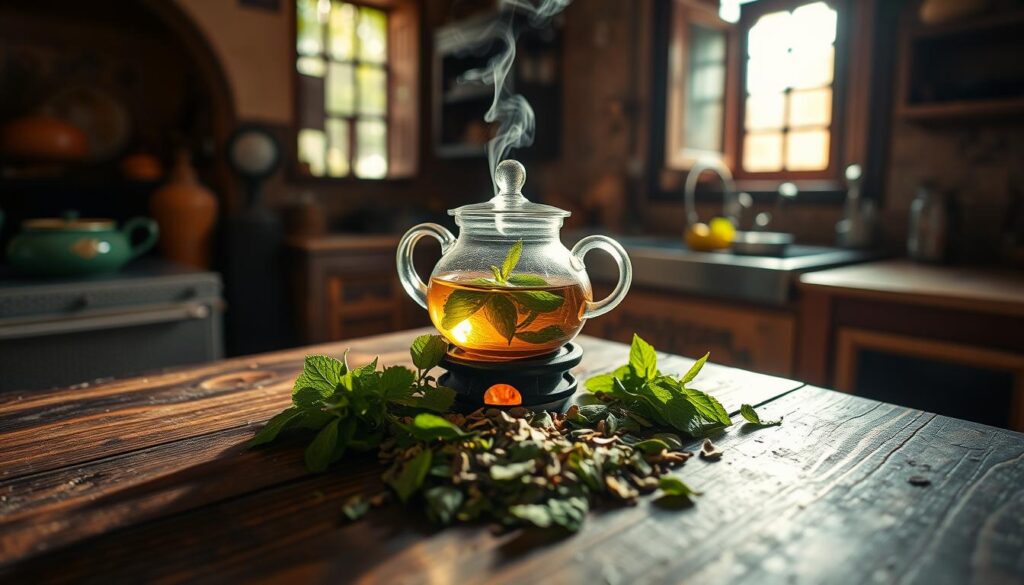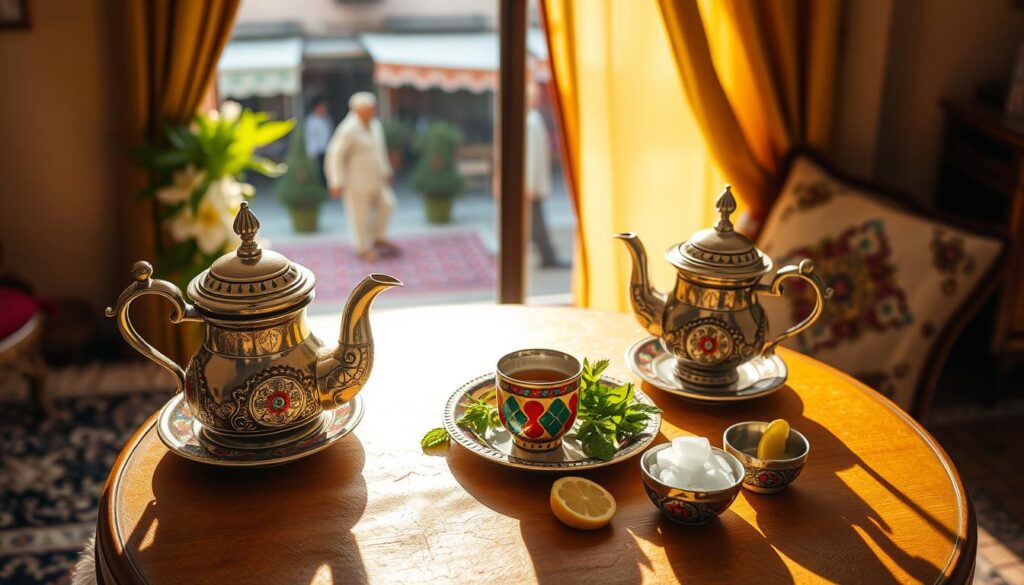Moroccan Mint Tea
Table of Contents
Moroccan Mint Tea
Imagine a beverage so vital to daily life that its preparation follows centuries-old rituals. This aromatic infusion isn’t just a drink – it’s a gesture of friendship woven into every social interaction across North Africa. The tradition involves pouring it from heights to create foam, symbolizing respect between host and guest.
At its core, this refreshment combines pungent green leaves with crisp spearmint and sweetener. The base ingredient isn’t ordinary – it’s tightly rolled pellets that unfurl in hot water, releasing bold flavors. Proper brewing requires precise temperatures and patience, transforming simple components into layered harmony.
You’ll discover how this drink shapes meals, business deals, and family gatherings. Our guide reveals expert techniques to balance bitterness with sweetness while honoring cultural roots. We’ll explore why the choice of glassware matters as much as ingredient ratios.
Key Takeaways
- Cultural cornerstone symbolizing hospitality and connection
- Requires specific green tea varieties and fresh herbs
- Brewing temperature impacts flavor intensity
- Integral to social rituals and daily routines
- Customizable sweetness levels for personal preference
Discover the Rich Culture and History Behind Moroccan Mint Tea
In North Africa, a steaming pot isn’t just about refreshment—it’s a language of connection spoken through fragrant steam and clinking glasses. The ritual of serving three pours from height isn’t mere theatrics; it’s a choreographed dance of respect where each glass carries distinct symbolism. Locals say the first pour tastes like life’s gentle moments, the second bursts with boldness, and the third whispers sweetness—mirroring life’s complex layers.
Cultural Significance in North Africa
Across households in the region, the act of sharing this brew defines social bonds. You’ll find it bridging business negotiations and family reunions alike—no gathering feels complete without its presence. Hosts often adjust sweetness levels using sugar to reflect their guest’s importance, while fresh green leaves release earthy tones that mingle with crisp herbs.
Historical Origins and Traditions
This tradition blossomed in the 1800s when trade routes brought tightly rolled gunpowder leaves to coastal ports. Locals blended these with wild mint growing near riverbanks, creating a drink that cooled bodies and warmed friendships. By the late 19th century, the custom of serving three glasses—each steeped longer for varying intensity—had become a marker of status from Marrakech to Tunis.
How to Brew the Perfect moroccan mint tea
Crafting this iconic drink requires more than ingredients—it’s a dance of precision and tradition. Let’s break down the essentials for capturing its layered aroma and cultural essence.

Preparing Your Ingredients and Equipment
Start with quality components:
- Fresh spearmint (1 large handful)
- Gunpowder green leaves (1 tbsp)
- Caster sugar (2-3 tbsp)
- Filtered boiled water (500ml)
Use a stainless steel stovetop kettle or traditional pot. Rinse leaves briefly in cold water to awaken their earthy notes—this step removes bitterness while preserving flavor compounds.
Step-by-Step Brewing Process
- Heat your kettle with a splash of boiled water, swirling to warm the metal
- Add leaves and pour 100ml hot water (80°C). Swirl gently, then discard this rinse
- Pack mint stalks into the pot, followed by sugar and remaining water
- Simmer 5 minutes—watch for tiny bubbles but avoid rolling boils
Let steep 3 minutes off heat. Stir once clockwise to blend sweetness evenly. Serve in heatproof glasses, topping with fresh herb sprigs for visual flair. The gradual infusion unlocks crisp aroma while honoring time-tested methods central to regional food customs.
Essential Ingredients and Equipment
Creating authentic flavors starts with selecting the right tools and components. While modern kitchens offer shortcuts, true enthusiasts know certain elements can’t be compromised. Let’s explore what makes this ritual both practical and symbolic.
The Role of Gunpowder Tea and Fresh Mint
Gunpowder tea forms the backbone of this iconic blend. Its tightly rolled leaves slowly release bold, smoky notes during brewing. Always rinse them first with a half cup of boiling water—this removes bitterness while awakening hidden flavors.
Fresh herbs add brightness to balance the earthiness. Spearmint works best, its crisp aroma cutting through the richness. For equipment, a stainless steel kettle mimics traditional designs, allowing controlled pouring essential for layering tastes.
| Ingredient | Role | Pro Tip |
|---|---|---|
| Gunpowder tea | Base flavor with smoky depth | Store in airtight containers |
| Fresh mint | Adds cooling freshness | Use stems for extra aroma |
| White sugar | Balances bitterness | Adjust during second brew |
| Kettle | Controls temperature | Pre-warm with hot water |
Why is the drink tea served three times during ceremonies? Each pour extracts different qualities—light, strong, then mellow. This sequence honors North African hospitality traditions while showcasing the leaves’ versatility.
Modern recipes Moroccan enthusiasts love still follow these steps. By respecting proportions and techniques, you preserve the soul of traditional Moroccan practices. Even small choices—like water temperature or steeping time—impact the final harmony.
Tips for Customizing Your Tea Experience
Your cup becomes a canvas when you master the art of personalization. Historical records show 19th-century hosts often added wild herbs to reflect seasonal abundance—a practice still shaping modern cuisine. Let’s explore how to make each sip uniquely yours.

Herbal Twists Beyond Tradition
Try layering flavors with aromatic additions. Lemon verbena adds citrusy brightness, while orange blossom water introduces floral depth. If fresh herbs are scarce, dried rose petals or thyme work beautifully. Start with 1/4 teaspoon per kettle to avoid overpowering the base flavor.
Tailoring Strength and Sweetness
Adjust sugar gradually—add 1 tsp at a time until balanced. For bolder taste, steep leaves 30 seconds longer. Lighter drink? Use cooler water (75°C) in your kettle. Remember, 19th-century brewers believed perfect harmony mirrored life’s rhythms—strong yet smooth.
Experiment with different vessels:
- Clay pots intensify earthy notes
- Glass teapots let you watch leaves dance
- Copper kettles enhance heat retention
Share your creations on a blog or social feed. Like generations before you, you’re continuing a story where every cup carries personal meaning. What new flavor combinations will define your taste journey?
Conclusion
Behind each aromatic cup lies generations of tradition waiting to be shared. Perfecting this beloved drink at home starts with respecting the process—rinsing leaves, heating your pot thoroughly, and pouring with purpose. The right amount of care transforms simple ingredients into a symbol of hospitality cherished for centuries.
Use quality gunpowder leaves and fresh herbs for authentic flavor. Stir from the bottom to blend sweetness evenly, and consider a lemon slice to brighten each glass. Serve in clear glasses to admire the amber hue—a visual nod to centuries of refinement.
This ritual isn’t just about what’s in your glass. It’s a way to connect with history while creating new memories. Share it generously with friends, honoring hospitality traditions that have warmed homes for generations. With patience and practice, you’ll master the process, crafting more than a drink—a timeless custom alive in every pour.







